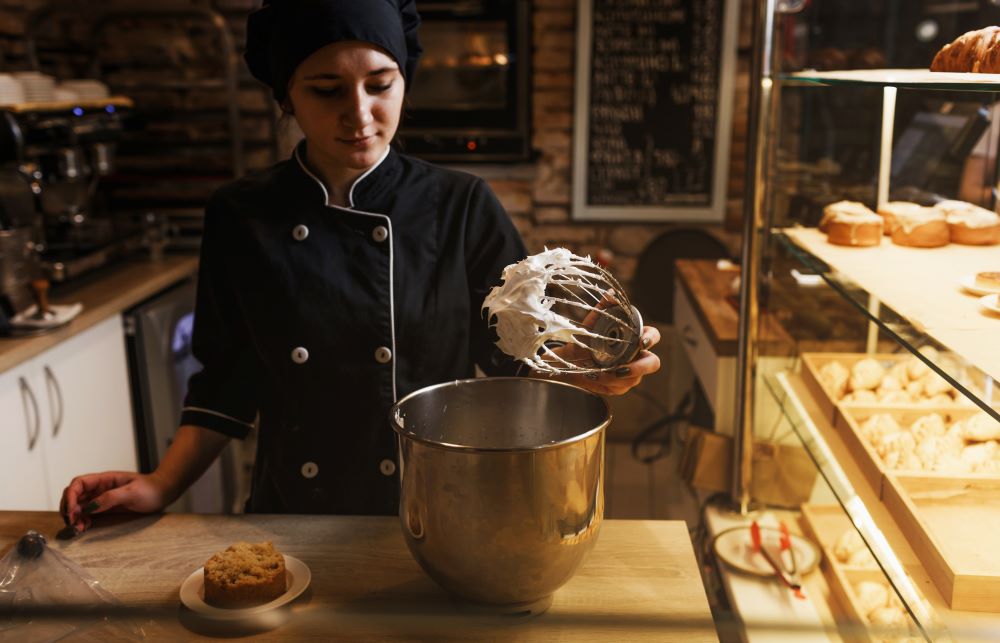How to start a home baking business: An expert guide

Martin Maravattickal
30 mins read

The home baking trend has seen a significant rise in popularity in India, particularly in urban areas where consumers are increasingly seeking personalized, artisanal, and healthier options over store-bought baked goods. This trend is fueled by several factors:
- Cultural Shifts: There is a growing appreciation for homemade food as people seek healthier eating options and wish to avoid preservatives and artificial ingredients common in commercially produced items.
- Social Media Influence: Platforms like Instagram and Facebook have allowed home bakers to showcase their creations, inspiring others to start baking at home. Social media also serves as a powerful marketing tool, enabling home bakers to reach a wide audience.
- Increased Disposable Income: As disposable incomes rise, so does spending on specialty products, including custom cakes, pastries, and other baked goods that are perceived as premium compared to their mass-produced counterparts.
- Pandemic Influence: The COVID-19 pandemic led many to start baking at home as a hobby or a way to pass the time, which in turn sparked interest in turning this hobby into a business.
Benefits of Starting a Home Baking Business
- Low Startup Costs: Unlike traditional storefronts, a home baking business does not require high capital investment for retail space. Initial costs may include kitchen equipment, ingredients, and basic marketing materials.
- Flexibility: Operating from home allows business owners to set their own hours and scale the business according to their personal commitments and goals. This flexibility is particularly appealing to individuals who need to balance work with other responsibilities like childcare or education.
- Creative Outlet: Baking allows for creative expression through the creation of unique recipes, designs, and flavors. It offers the satisfaction of crafting products that bring joy to customers during special occasions.
- Community Connection: Home bakers often enjoy a close relationship with their local community. This can lead to strong customer loyalty and word-of-mouth referrals, which are invaluable for business growth.
- Potential for Growth: Starting small doesn’t mean staying small. Many home bakers eventually expand into larger operations or open retail locations. There is also the potential to diversify product offerings to include baking classes, online tutorials, or baking kits.
Understanding the Market
Researching Local Demand for Baked Goods
Understanding local demand is crucial for any business, especially for home bakers who need to cater to the tastes and preferences of their community. Here’s how to effectively research local demand:
- Surveys and Feedback: Conduct surveys within your community, either online or in person, to understand preferences and demand for specific types of baked goods. Social media can be an excellent tool for this purpose.
- Market Analysis: Analyze existing bakeries and home baking businesses in the area to assess what products are available and which items are popular. Identify gaps in the market where your business could potentially thrive.
- Attend Local Events: Participate in local fairs, markets, and food festivals to observe firsthand what consumers are buying. This can also serve as a testing ground for your products.
- Demographic Study: Understanding the demographics of your area, including age, income levels, and cultural background, can help tailor your offerings to the needs and preferences of your community.
- Seasonal Preferences: Note the seasonal variations in consumer preferences. For instance, certain Indian sweets might be more popular during festivals like Diwali or Eid.
Identifying Your Target Market and Niche
Once you have a sense of the local demand, it’s important to define your target market and niche. This helps in focusing your marketing efforts and product development to appeal directly to your ideal customers.
- Target Market Definition: Determine who your ideal customers are based on factors like age, lifestyle, income level, and eating habits. For example, young professionals might prefer quick, on-the-go desserts, while families might look for custom birthday cakes.
- Choosing a Niche: Select a niche that not only interests you but also meets the needs of your target market. Niches in home baking might include:
- Organic Baking: Catering to health-conscious consumers looking for baked goods made from organic, non-GMO ingredients.
- Vegan and Allergy-Friendly Baking: Offering vegan options or products free from common allergens like gluten, nuts, and dairy.
- Specialty Desserts: Focusing on unique or culturally specific items that might not be readily available in the market, such as fusion desserts or traditional regional sweets with a modern twist.
- Unique Selling Proposition (USP): Define what makes your offerings unique compared to others in the market. Whether it’s a unique flavor, personalized design, or superior quality, your USP can help you stand out.
- Feedback and Iteration: Launch with a small selection of products and solicit feedback. Use this feedback to refine your offerings and better serve your target market.
Business Planning

Setting Clear Business Goals
Establishing clear, achievable goals is critical for any new business as it provides direction and benchmarks for measuring success. Here’s how to set effective business goals:
- Short-Term and Long-Term Goals: Define what you want to achieve in the short term (1 year) and long term (5 years). These could range from sales targets and customer numbers to product development and market expansion.
- SMART Goals: Ensure your goals are Specific, Measurable, Achievable, Relevant, and Time-bound. For example, a goal could be to sell 50 cakes per month by the end of the first year.
- Financial Objectives: Set financial targets such as revenue, profit margins, and cash flow. Determine the break-even point to understand how long it will take to become profitable.
- Customer Engagement Goals: Decide on objectives related to customer satisfaction and retention, such as achieving a certain number of repeat customers or maintaining excellent customer service ratings.
- Growth Aspirations: Plan for the expansion of your product line or services, like introducing seasonal items, catering for events, or starting baking classes by a certain date.
Creating a Business Plan
A comprehensive business plan is essential for structuring your business, securing any needed funding, and guiding your operations. Here’s what to include in your business plan:
- Executive Summary: Start with an overview of your business concept, the products you will offer, and your unique value proposition.
- Market Analysis: Include detailed research on your target market, industry trends, and competitor analysis. This section should demonstrate your understanding of the market and where your business fits.
- Business Structure: Describe the legal structure of your business (sole proprietorship, partnership, LLC, etc.). Outline your business operations, the roles and responsibilities of the management team, and any staffing requirements.
- Product Line: Detail the types of products you will offer, highlighting any special or unique offerings. Discuss product development, sourcing of ingredients, and any proprietary processes.
- Marketing and Sales Strategy: Explain how you plan to attract and retain customers. This should include pricing strategies, advertising, promotions, and distribution channels.
- Budgeting and Financial Planning: Provide comprehensive financial projections, including start-up costs, operating costs, revenue forecasts, and profitability analysis. Use realistic assumptions to create a budget that covers all expected expenses.
- Funding Requirements: If you need initial funding, specify the amount required and how it will be used. Include potential funding sources, such as loans, investments, or grants.
- Risk Management: Identify potential risks to your business, including market fluctuations, regulatory changes, or operational challenges, and how you plan to mitigate them.
Legal Requirements
Necessary Registrations and Licenses
In India, starting a home baking business requires complying with several legal requirements to ensure food safety and business legitimacy:
- FSSAI Registration: The Food Safety and Standards Authority of India (FSSAI) requires all food businesses, including small-scale or home-based operations, to obtain a registration or license. The type of registration or license depends on the scale of your business and your annual turnover.
- Basic Registration: For businesses with a turnover of less than ₹12 lakh per year.
- State License: For businesses with a turnover between ₹12 lakh and ₹20 crore.
- Central License: For businesses with a turnover above ₹20 crore.
- GST Registration: If your turnover exceeds the threshold limit (currently ₹40 lakh for goods, ₹20 lakh for services), registration under the Goods and Services Tax (GST) is mandatory. This allows you to issue tax invoices to your customers.
- Trade License: Obtain a trade license from the local municipality. This license is a basic requirement for any form of business and ensures you comply with local business regulations.
- Health License: Some local authorities might require a health license, which ensures that your business meets specific health standards.
Understanding the Local Health and Safety Regulations

Health and safety are paramount in any food-related business. Here’s how to ensure compliance with local regulations:
- Local Health Department Guidelines: Check with your local health department to understand specific requirements for home bakeries. This may include kitchen hygiene, food handling practices, and pest control measures.
- Regular Inspections: Be prepared for regular inspections by health officials, who will check for cleanliness, proper food storage, and waste disposal practices.
- Food Safety Training: It is advisable to undergo formal training in food safety and handling. Courses offered by recognized institutions can provide certifications that not only boost your credibility but also ensure you are knowledgeable about best practices.
- Equipment and Facility Requirements: Ensure that your baking equipment and kitchen facilities meet the standards set by local regulations. This includes proper ventilation, food-grade surfaces, and adequate storage facilities for raw materials and finished products.
- Labeling Requirements: Understand and comply with labeling regulations, which include listing ingredients, allergens, and expiry dates on your product packaging.
Setting Up Your Baking Space
Requirements for a Home Bakery Kitchen
When setting up a kitchen for a home bakery, certain key elements need to be considered to comply with regulations and ensure efficient operation:
- Space and Layout: Design your kitchen layout to streamline the baking process. Ideally, the kitchen should have a logical flow from the storage area to the preparation, baking, and cooling areas, and finally to the packaging and dispatch area.
- Surfaces and Materials: Use materials that are easy to clean and maintain. Surfaces such as stainless steel or food-grade silicone are preferred because they don’t harbor bacteria and can withstand frequent cleaning.
- Equipment: Invest in professional-grade equipment that suits the volume of your production. Essential equipment might include an oven, mixer, proofing cabinets, and refrigeration units. Also, consider the electrical capacity of your home to handle this equipment.
- Ventilation: Proper ventilation is crucial to remove excess heat and maintain a comfortable working environment. This might include installing range hoods or exhaust fans.
- Storage: Adequate storage for both perishable and non-perishable goods is necessary. Ingredients should be stored in airtight containers to prevent contamination and extend their shelf life.
- Safety Equipment: Install fire extinguishers and ensure you have a first-aid kit accessible. It’s also important to have clear markings for emergency exits.
Optimizing Your Baking Space for Efficiency
To maximize productivity and ease of operation in your home bakery, consider the following tips for optimizing your kitchen space:
- Work Zones: Set up dedicated zones for each stage of the baking process — storage, prep, baking, cooling, and packaging. This reduces time spent moving between tasks and minimizes cross-contamination.
- Ergonomics: Arrange equipment and supplies to minimize strain and movement. For example, place frequently used ingredients on easily reachable shelves and ensure that work surfaces are at a comfortable height.
- Scalable Solutions: As your business grows, your kitchen should be able to adapt. Choose equipment and storage solutions that can expand or be enhanced as needed.
- Energy Efficiency: Opt for energy-efficient appliances to reduce electricity costs. LED lighting and energy-star rated ovens and refrigerators can make a significant difference in your utility bills.
- Cleaning Systems: Develop a robust cleaning protocol to keep your workspace sanitary. This includes daily cleaning routines and deeper cleans for equipment and hard-to-reach areas.
- Mobile and Multipurpose Furniture: Use mobile carts that can be moved around as needed and consider furniture that can serve multiple purposes, such as a worktable with built-in storage.
Equipment and Supplies

Essential Baking Tools and Equipment
For a home bakery, having the right tools can make the process more efficient and enjoyable. Here’s a list of essential baking tools and equipment:
- Oven: A reliable and accurate oven is crucial. Consider investing in a convection oven for even baking.
- Mixers: A sturdy stand mixer is invaluable for a variety of tasks, from kneading dough to whipping cream.
- Weighing Scale: Precision is key in baking, so a digital scale is a must-have for measuring ingredients accurately.
- Measuring Cups and Spoons: For ingredients that need volume measurement, good quality measuring cups and spoons are essential.
- Baking Pans and Sheets: A selection of baking pans and sheets in various shapes and sizes, including round and square cake pans, muffin tins, and cookie sheets.
- Cooling Racks: These allow air to circulate around freshly baked goods, preventing sogginess.
- Food Processor: Useful for quickly accomplishing tasks like chopping nuts, blending pastry dough, or making icings.
- Silicone Baking Mats or Parchment Paper: These non-stick surfaces are important for baking cookies and pastries that could stick to the pan.
- Thermometer: A good-quality food thermometer to check the doneness of cakes and breads, and a candy thermometer if you plan to make candies or chocolates.
- Utensils: Rubber spatulas, wooden spoons, whisks, and pastry brushes are indispensable tools in a baker’s kitchen.
Sourcing Quality Ingredients and Reliable Suppliers
The quality of your baked goods heavily depends on the ingredients you use. Here’s how to ensure you’re sourcing the best:
- Research Suppliers: Look for suppliers who specialize in high-quality baking ingredients. If possible, choose local suppliers to ensure freshness and support the local economy.
- Bulk Purchasing: For ingredients used frequently, consider buying in bulk to reduce costs. Ensure that you have adequate storage to maintain their freshness.
- Seasonal Ingredients: Take advantage of seasonal produce by incorporating them into your offerings. This not only enhances flavor but also appeals to customers looking for seasonal variety.
- Organic and Specialty Ingredients: If your niche includes organic or specialty products (like gluten-free or vegan), ensure your suppliers can provide these ingredients with consistent quality.
- Sample Batches: Before committing to a large purchase from a new supplier, ask for samples to test the quality of the ingredients.
- Build Relationships: Developing a good relationship with suppliers can lead to benefits such as better prices, priority order fulfillment, and insights into new or improved ingredients.
- Regular Audits: Regularly evaluate your suppliers based on the quality of their products and their delivery reliability to ensure they continue to meet your standards.
Pricing Your Products
Cost Calculation Methods
Effective cost calculation ensures that you know the true cost of producing your baked goods, allowing you to price them appropriately. Here are key steps to calculate costs:
- Direct Costs: These are costs directly associated with production, including ingredients and packaging. Keep detailed records of these expenses for each type of product you make.
- Indirect Costs: These include overheads such as electricity, water, kitchen equipment depreciation, and rent (if applicable). Allocate a portion of these costs to each product based on usage.
- Labor Costs: Even if you are the sole employee, factor in your time as a cost. Determine how much time is spent on different tasks (baking, decorating, cleaning, etc.) and assign a labor cost to each product accordingly.
- Miscellaneous Costs: Include small costs that can add up, such as transportation, marketing, and selling expenses.
Strategies for Competitive Pricing While Ensuring Profitability
Setting the right price for your products is crucial—it must cover all costs and deliver a profit while remaining attractive to customers. Here’s how to set competitive and profitable pricing:
- Market Research: Understand the pricing landscape by researching what competitors charge for similar products. Adjust your prices based on your market position and product uniqueness.
- Perceived Value: Price products based on the value perceived by the customer. Use quality ingredients and unique designs to justify higher prices.
- Tiered Pricing: Offer products at different price points to cater to various customer segments. For example, basic cupcakes and high-end custom cakes can target different markets.
- Cost-Plus Pricing: Add a markup to your costs to ensure profitability. A common approach is to set a markup that covers costs and provides a profit margin, typically between 20% and 50% above cost.
- Psychological Pricing: Use pricing strategies that make the cost more appealing, such as setting prices slightly lower than a round number (e.g., ₹499 instead of ₹500).
- Volume Discounts: Encourage larger orders by offering discounts on bulk purchases. This can increase overall sales while reducing per-unit costs.
- Dynamic Pricing: Adjust prices based on demand and seasonality. For instance, you might charge more for holiday-themed goods during festive seasons.
Branding and Marketing

Creating a Brand Identity
A strong brand identity makes your bakery memorable and can significantly influence customer perception and loyalty. Here are key components to consider:
- Logo: Design a logo that reflects the style and personality of your bakery. It should be recognizable and scalable, working well on everything from business cards to signage. Consider hiring a professional designer or using design platforms if you’re on a budget.
- Color Scheme: Choose a color palette that resonates with your brand’s values and target market. Soft pastels might appeal to high-end clients, while vibrant colors could attract a younger, fun-loving demographic.
- Typography: Select one or two fonts that complement your brand’s style and are legible across various media.
- Packaging: Design packaging that not only protects your products but also enhances your brand. Custom boxes, stickers, and tissue paper can turn even the simplest baked goods into special treats.
- Consistent Theme: Your brand identity should be consistent across all platforms and materials. This includes your website, social media profiles, packaging, and any promotional materials.
Utilizing Social Media and Other Digital Marketing Strategies
Digital marketing is essential for reaching potential customers and building relationships. Here are effective strategies for a home bakery:
- Social Media Presence: Establish a strong presence on platforms like Instagram, Facebook, and Pinterest, where visual appeal drives engagement. Regularly post high-quality photos of your products, behind-the-scenes glimpses, and customer testimonials.
- Content Marketing: Create valuable content that can help solve problems for your customers. Blog posts about baking tips, recipes, and the latest dessert trends can attract a broader audience to your site.
- Email Marketing: Build an email list by offering a sign-up incentive like a discount or free recipe booklet. Use this channel to inform subscribers about new products, special offers, and events.
- SEO (Search Engine Optimization): Optimize your website content to rank higher in search engine results. This includes using relevant keywords, optimizing images and videos, and ensuring your website is mobile-friendly.
- Paid Advertising: Consider using paid ads on social media or Google to reach a targeted audience. Start with a small budget to test what works best for your products and audience.
- Influencer Collaborations: Partner with food bloggers and influencers who can help promote your products. Choose influencers whose followers match your target demographic.
- Customer Engagement: Engage with your followers by responding to comments, asking for feedback, and running interactive contests or polls.
Sales Channels
Setting Up an Online Store or Website
Having an online store or website not only increases your reach but also provides a platform for customers to learn more about your business. Here are the steps to set up an effective online presence:
- Choose a Platform: Select a website builder or e-commerce platform that fits your needs and budget. Popular choices for small businesses include Shopify, Wix, and WordPress with WooCommerce.
- Domain Name: Choose a domain name that matches your business name to maintain consistency and brand recognition.
- Design: Design your website to reflect your brand identity. It should be visually appealing, easy to navigate, and optimized for mobile devices.
- Product Listings: Include clear, high-quality images and detailed descriptions for each product. Categories and filters can help customers easily find what they’re looking for.
- Payment Gateway: Set up a secure payment gateway to handle transactions. Options like PayPal, Stripe, and local banking integrations are popular.
- Shipping Options: Decide whether you will offer local delivery, nationwide shipping, or both. Clearly outline shipping costs and policies.
- Marketing Tools: Utilize built-in SEO tools to improve your site’s visibility and consider integrating email marketing tools to keep in touch with customers.
Exploring Offline Sales Through Local Markets or Collaboration with Cafes and Restaurants
Expanding into offline sales can increase your market penetration and brand visibility. Here’s how to explore these avenues:
- Local Markets and Food Fairs: Participate in local markets and food fairs to reach a broader audience. These events are great for building brand awareness and interacting directly with customers.
- Packaging and Presentation: Ensure your products are well-packaged and presented attractively to catch the eye of passersby. Consider offering samples to draw in potential customers.
- Collaboration with Cafes and Restaurants: Identify local cafes and restaurants that align with your brand and offer to supply them with unique baked goods. This can be a steady source of income and increase your brand’s credibility.
- Wholesale Options: Offer your products at a wholesale rate to local stores or specialty food shops. This requires consistent production capacity and quality.
- Catering Events: Offer your services for catering at events like birthdays, weddings, or corporate functions. This can also include custom orders for special occasions.
- Networking: Build relationships within your community. Attend local business events and join community business groups to connect with potential partners and customers.
Customer Service

Managing Orders and Customer Feedback
Properly managing orders ensures that your operations run smoothly and that your customers are satisfied, while actively seeking and responding to feedback can significantly improve your business.
- Order Management System: Use a system to track orders from placement to delivery. This could be as simple as a spreadsheet or as sophisticated as specialized software that integrates with your website.
- Clear Communication: Keep customers informed about the status of their orders through automated emails or messages. Provide clear information on delivery times, any potential delays, and how they can contact you if necessary.
- Feedback Mechanisms: Implement mechanisms for collecting feedback, such as follow-up emails, comment cards with deliveries, or a feedback section on your website. Encourage customers to share their experiences and suggestions.
- Respond to Feedback: Acknowledge both positive and negative feedback. Respond promptly and thoughtfully to any issues raised by customers, and let them know you value their input and are making efforts to address their concerns.
- Continuous Improvement: Use customer feedback to continuously improve your products and services. Identify common threads or suggestions for improvement and implement changes accordingly.
Building Customer Relationships for Repeat Business
Building strong, ongoing relationships with customers encourages repeat business and can turn customers into advocates for your brand.
- Personalized Experiences: Offer personalized experiences whenever possible, such as remembering customer preferences or suggesting products based on previous purchases. This shows customers that you value them as individuals.
- Loyalty Programs: Create a loyalty program that rewards repeat customers with discounts, free products, or early access to new items. This not only incentivizes repeat purchases but also makes customers feel appreciated.
- Exclusive Offers: Send exclusive offers to your regular customers or email subscribers. This could include special promotions, birthday discounts, or invites to exclusive events or product launches.
- Engage on Social Media: Use social media to maintain a connection with customers. Post engaging content regularly, respond to comments, and share customer posts that feature your products.
- Community Involvement: Get involved in your local community through sponsorships, donations, or participating in community events. This builds your local reputation and can deepen customer loyalty.
- Regular Communication: Maintain regular communication through newsletters, updates about your bakery, or sharing behind-the-scenes content. Keeping your bakery on customers’ minds can help drive repeat business.
Scaling the Business
Tips for Expanding Product Lines or Services
Diversifying your offerings can attract new customers and provide more value to existing ones, helping to increase overall sales.
- Market Research: Before adding new products or services, conduct market research to identify trends and customer preferences. This helps ensure that there is demand for what you plan to offer.
- Complementary Products: Introduce products that complement your existing offerings. For example, if you sell cakes, consider adding cookies, cupcakes, or cake pops.
- Seasonal Offerings: Develop seasonal products that cater to various holidays and events throughout the year. This keeps your product line fresh and engaging for customers.
- Customization Services: Offer customization options for your products, such as personalized designs for cakes or special ingredient substitutions for dietary restrictions.
- Baking Classes and Workshops: Expand your services to include baking classes or workshops. This not only provides another revenue stream but also engages your community and builds brand loyalty.
- Subscription Services: Consider offering a subscription service where customers receive a selection of baked goods monthly. This creates a steady income stream and increases customer retention.
Strategies for Growing Your Customer Base and Increasing Sales
Attracting more customers and boosting sales are key objectives for any growing business. Here are effective strategies to achieve these goals:
- Optimize Your Online Presence: Ensure your website is optimized for search engines and user experience. A strong online presence helps attract new customers through organic search.
- Social Media Marketing: Use social media platforms to reach a broader audience. Regular posts featuring new products, promotions, and behind-the-scenes content can engage potential customers.
- Networking and Partnerships: Network with other local businesses and consider partnerships that can help expose your products to a wider audience. For example, supplying your baked goods to local cafes or collaborating on events.
- Promotions and Discounts: Run promotions or offer discounts to draw in new customers and encourage repeat business. Limited-time offers can create urgency and boost sales.
- Referral Programs: Implement a referral program that rewards customers for bringing in new business. This can effectively turn your existing customer base into brand ambassadors.
- Community Engagement: Get involved in community events, markets, and fairs where you can showcase your products and interact directly with potential customers.
- Customer Service: Excellent customer service can set your business apart and encourage word-of-mouth recommendations. Always strive to exceed customer expectations.
Conclusion
Embarking on a home baking business journey in India combines passion with opportunity. As this guide illustrates, understanding the market, aligning with
legal requirements, and setting up an efficient baking space form the pillars of a successful home bakery. With the rise of social media and changing
consumer preferences, the potential for home bakers is significant. By investing in quality tools and ingredients, carefully crafting your brand, and
engaging with your community both online and offline, you can turn your home baking business into a thriving enterprise.
Remember, the key to success lies in your ability to adapt and innovate. Whether it’s through expanding your product offerings or exploring new marketing
strategies, staying responsive to customer needs and market trends will help you grow. The journey might be sprinkled with challenges, but the rewards
of bringing joy to people through your culinary creations are immensely fulfilling.
We encourage you to use this guide as a stepping stone to build a business that not only achieves financial success but also reflects your passion for
baking. Bake with love, serve with pride, and enjoy every moment of your home baking adventure!